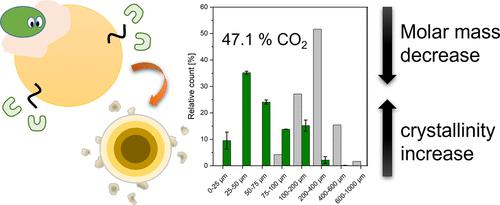当前位置:
X-MOL 学术
›
Environ. Sci. Technol.
›
论文详情
Our official English website, www.x-mol.net, welcomes your
feedback! (Note: you will need to create a separate account there.)
Effect of Polymer Properties on the Biodegradation of Polyurethane Microplastics
Environmental Science & Technology ( IF 10.8 ) Pub Date : 2022-11-17 , DOI: 10.1021/acs.est.2c05602 Patrizia Pfohl 1, 2, 3 , Daniel Bahl 1 , Markus Rückel 1 , Marion Wagner 1 , Lars Meyer 1 , Patrick Bolduan 1 , Glauco Battagliarin 1 , Thorsten Hüffer 2 , Michael Zumstein 2 , Thilo Hofmann 2 , Wendel Wohlleben 1
Environmental Science & Technology ( IF 10.8 ) Pub Date : 2022-11-17 , DOI: 10.1021/acs.est.2c05602 Patrizia Pfohl 1, 2, 3 , Daniel Bahl 1 , Markus Rückel 1 , Marion Wagner 1 , Lars Meyer 1 , Patrick Bolduan 1 , Glauco Battagliarin 1 , Thorsten Hüffer 2 , Michael Zumstein 2 , Thilo Hofmann 2 , Wendel Wohlleben 1
Affiliation

|
The release of fragments from plastic products, that is, secondary microplastics, is a major concern in the context of the global plastic pollution. Currently available (thermoplastic) polyurethanes [(T)PU] are not biodegradable and therefore should be recycled. However, the ester bond in (T)PUs might be sufficiently hydrolysable to enable at least partial biodegradation of polyurethane particles. Here, we investigated biodegradation in compost of different types of (T)PU to gain insights into their fragmentation and biodegradation mechanisms. The studied (T)PUs varied regarding the chemistry of their polymer backbone (aromatic/aliphatic), hard phase content, cross-linking degree, and presence of a hydrolysis-stabilizing additive. We developed and validated an efficient and non-destructive polymer particle extraction process for partially biodegraded (T)PUs based on ultrasonication and density separation. Our results showed that biodegradation rates and extents decreased with increasing cross-linking density and hard-segment content. We found that the presence of a hydrolysis stabilizer reduced (T)PU fragmentation while not affecting the conversion of (T)PU carbon into CO2. We propose a biodegradation mechanism for (T)PUs that includes both mother particle shrinkage by surface erosion and fragmentation. The presented results help to understand structure–degradation relationships of (T)PUs and support recycling strategies.
中文翻译:

聚合物性能对聚氨酯微塑料生物降解的影响
塑料制品碎片的释放,即二次微塑料,是全球塑料污染背景下的一个主要问题。目前可用的(热塑性)聚氨酯 [(T)PU] 不可生物降解,因此应回收利用。然而,(T)PU 中的酯键可能足以水解,以使聚氨酯颗粒至少部分生物降解。在这里,我们研究了不同类型 (T)PU 堆肥中的生物降解,以深入了解它们的碎片和生物降解机制。所研究的 (T)PU 在聚合物主链(芳香族/脂肪族)的化学性质、硬相含量、交联度以及水解稳定添加剂的存在方面各不相同。我们开发并验证了基于超声波处理和密度分离的部分生物降解 (T)PU 的高效且无损的聚合物颗粒提取工艺。我们的结果表明,生物降解速率和程度随着交联密度和硬链段含量的增加而降低。我们发现水解稳定剂的存在减少了(T)PU 碎裂,同时不影响(T)PU 碳转化为CO 2。我们提出了一种 (T)PU 的生物降解机制,其中包括表面侵蚀和破碎导致的母颗粒收缩。所提出的结果有助于理解 (T)PU 的结构-降解关系并支持回收策略。
更新日期:2022-11-17
中文翻译:

聚合物性能对聚氨酯微塑料生物降解的影响
塑料制品碎片的释放,即二次微塑料,是全球塑料污染背景下的一个主要问题。目前可用的(热塑性)聚氨酯 [(T)PU] 不可生物降解,因此应回收利用。然而,(T)PU 中的酯键可能足以水解,以使聚氨酯颗粒至少部分生物降解。在这里,我们研究了不同类型 (T)PU 堆肥中的生物降解,以深入了解它们的碎片和生物降解机制。所研究的 (T)PU 在聚合物主链(芳香族/脂肪族)的化学性质、硬相含量、交联度以及水解稳定添加剂的存在方面各不相同。我们开发并验证了基于超声波处理和密度分离的部分生物降解 (T)PU 的高效且无损的聚合物颗粒提取工艺。我们的结果表明,生物降解速率和程度随着交联密度和硬链段含量的增加而降低。我们发现水解稳定剂的存在减少了(T)PU 碎裂,同时不影响(T)PU 碳转化为CO 2。我们提出了一种 (T)PU 的生物降解机制,其中包括表面侵蚀和破碎导致的母颗粒收缩。所提出的结果有助于理解 (T)PU 的结构-降解关系并支持回收策略。











































 京公网安备 11010802027423号
京公网安备 11010802027423号